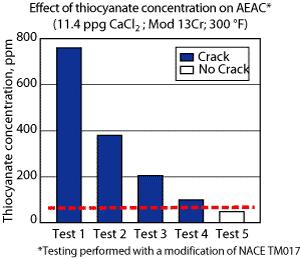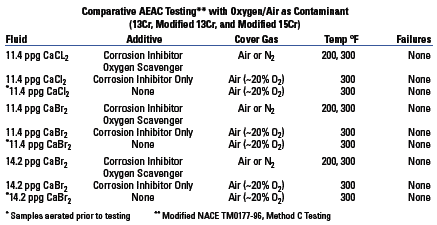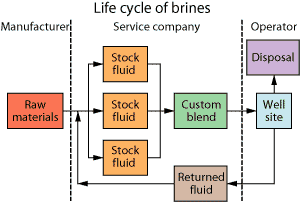Understanding Chemistry of Clear Brine Fluids … Best Performance
Selecting a Clear Brine Fluid (CBF) for deepwater completion is-or at least should be-a complex process. Impaired production experiences are caused by localized corrosion, stress crack failures of tubing metallurgy or by formation damage, as fluids react chemically with production gases or fluid additives. Besides technical complexity, economics drives operators to seek a thorough understanding of best practices for fluid selection and use. CBF cost can exceed $1 million dollars for some offshore completions.
SUGGESTED CITATION
Understanding The Chemistry Of Clear Brine Fluids Is Vital For Best Performance, E. J. Termine and T. Massoth, World Oil, 107 (2007).
INTRODUCTION
Selecting a Clear Brine Fluid (CBF) for deepwater completion is-or at least should be-a complex process. Impaired production experiences are caused by localized corrosion, stress crack failures of tubing metallurgy or by formation damage, as fluids react chemically with production gases or fluid additives. Besides technical complexity, economics drives operators to seek a thorough understanding of best practices for fluid selection and use. CBF cost can exceed $1 million dollars for some offshore completions.
CBFs are versatile materials. They are used as a displacement fluid to remove drilling muds, as drill-in fluids or as permanent packer fluid. Through proper selection of inorganic salt mixtures, a CBF can be formulated to balance nearly all wellbore pressures found in the field.
Understanding chemistry and chemical interactions of CBFs is essential for selecting the most cost-effective fluid, especially for the demanding requirements of high-pressure, high-temperature (HPHT) well completions.
EFFECT OF COMPOSITION ON CBF PERFORMANCE
A CBF is best viewed as a reactive or metastable system rather than inert or benign. Minor differences in chemical composition or the presence of ubiquitous impurities can have profound effects on fluid performance. Variations in raw materials and manufacturing processes, as well as differences in quality control procedures, product formulation and product composition can affect CBF performance.
True Crystallization Temperature (TCT) is determined by salt composition in the CBF. The crystallization temperature of a CBF can be influenced by changes in pressure, to give a unique Pressure Crystallization Temperature (PCT). Consequently, compositional effects on PCT, as well as on gas hydrate formation temperatures, must be recognized.
Likewise, proper selection of CBF can increase well productivity.
Other considerations leading to CBF composition changes can impact performance. CBFs can react with formation gases, such as H2S and CO2, which may form insoluble salts in the completion zone or near wellbore. Also, CBFs can become contaminated during displacement within the wellbore; care must be taken to assure fluid chemistry is not compromised.
CORROSION PREVENTION
Often overlooked, various additives and contaminants in CBFs can play a significant role in localized corrosion. Cracking that occurs from interaction between a CBF and production tubing is called Annular Environmentally Assisted Cracking (AEAC).
CBF composition can have a dramatic impact on general corrosion and AEAC in production tubing. In zinc-based fluids, we observed that corrosion can be reduced or eliminated by proper formulation, and stress corrosion cracking of metals is rare in properly formulated zinc-based brine fluids.
Engineered fluid systems. Today, the more demanding requirement of HPHT wells is driving the design of custom or engineered CBF systems. Consequently, the CBF selection process becomes more complex, especially when Corrosion Resistant Alloy (CRA) tubulars are used or when chemical additives are incorporated into the fluid.
It is important to understand the interaction of fluids with CRA tubulars and the factors involved in stress corrosion cracking. McKennis first recognized that the chemistry of the final formulated fluid, and not just the metallurgy, plays a significant role in the performance of fluids used in CRA well completions.1 The most extensive testing in this area is being conducted through a research alliance between a leading supplier of CBFs and a leading supplier of CRA tubulars.2 A joint industry program has been sponsored by the API.3
Thiocyanate effect on AEAC. Although thiocyanate has been implicated in many reported tubing/casing failures, no data have been reported quantifying the importance of this ubiquitous ion, despite its common usage with non-CRA tubing or casing and its presence in reclaimed brines. Figure 1 shows the effect of thiocyanate on AEAC for modified 13-Cr tubing using 11.4 ppg CaCl2 fluids. The data show thiocyanate at concentrations as low as about 100 ppm can cause stress corrosion cracking in CaCl2 fluids. Our studies in this area have shown that thiocyanate ions can promote stress cracking failures, even with no apparent production of H2S.
Additives with sulfur (such as thiocyanate corrosion inhibitors or other bisulfite/sulfite oxygen scavengers) should be screened in brines intended for use with CRA tubulars. In the absence of screening tests, materials containing sulfur should be avoided.

Fig. 1. Effect of thiocyanate concentration on stress crack corrosion.
Effect of oxygen/air on AEAC. The presence of oxygen in trace amounts in packer fluids has been cited as a key factor in several tubular failures. Table 1 shows the results of AEAC testing of several metallurgies in both chloride and bromide brines exposed to varying amounts of oxygen/air. Our studies on oxygen contamination show:
Oxygen/air is a common trace contaminant in brine fluids even with the use of oxygen scavengers.
Oxygen/air can lead to localized corrosion, but current AEAC studies reveal no exceptional impact on cracking induced by its presence.
Oxygen scavengers in packer fluid CBFs is recommended to minimize general and other localized corrosion.
Failures attributed to trace amounts of oxygen may be caused by other contaminants or factors.
TABLE 1. Effect of oxygen/air in the presence of corrosion inhibitors and oxygen scavengers on stress crack corrosion.
To fully appreciate the role of CBF quality and the effects of contaminants on performance, it is enlightening to examine a brine within the supply chain, Fig. 2. The manufacturer makes the individual salts that comprise a CBF. The chemical process that the manufacturer selects has an effect on downhole performance. For example, in the production of zinc bromide, the manufacturer might react bromine with zinc metal or, alternatively, hydrobromic acid with zinc oxide. The zinc bromide made from each of these processes will have different purity profiles.
Fig. 2. A Schematic of brines within the supply chain.
The service company usually manages inventories of several stock fluids. These stock fluids are used to make the custom CBF blend (single-, two- or three-salt blend for halide brines) and are designed to match density and crystallization requirements, or other important specifications in the case of an engineered fluid system designed for a specific well application. The custom CBF blend is then delivered to the operator’s well site.
The quality of a CBF and an engineered fluid system can be compromised at multiple points, from original manufacture of the brines through all transfers associated with selling, transporting and recycling. Care must be taken to clean and re-qualify the returned fluid before placing it into stock fluid storage.
SUMMARY/CONCLUSION
Operators should avoid the common misconception that clear brine fluids are generic, and that brines produced by manufacturers and sold by service companies are equivalent. Operators should consider the following points when selecting a fluid that matches the unique conditions of their well:
Engineered solutions focused on delivering CBF performance properties, based on matching well conditions with proper brine formulations, should be standard practice.
CBF compositional selections, such as a choice between single-, two- and three-salt formulations, can significantly affect the performance properties of brine fluids.
Proper formulation of equally dense brine fluids can lead to valuable performance benefits, such as production enhancement and corrosion prevention.
Additives and impurities found or expected in the well should be evaluated for CBF compatibility.
Clear brine fluids are inherently reactive systems whose components can change during their life cycle. Of special concern is the adventitious introduction of contaminants.
Minor differences in chemical composition or the presence of impurities introduced during logistics and field practices have profound effects on fluid performance. Variations in raw materials and manufacturing processes, quality control procedures, product formulation and compositions can impact the effectiveness of a well completion. WO
LITERATURE CITED
1 Jeffrey McKennis and Nam-Sook Bae, World Oil, July 2005; and Jeffrey McKennis, 2nd Annual ChemiMetallurgy (trademarked) Technical Symposium 2006, Nov., 2006 (slides accessible at www.technical-symposium.com).
2 TETRA Technologies, Inc. and JFE Steel Corporation formed the ChemiMetallurgy research alliance in 2003 to understand annular, environmentally assisted cracking, and compile a database assessing compatibility of clear brine fluids and production tubing.
3 “Testing of Heavy Brines.” Corrosion Resistant Alloy Test Program, API, SC-13, TG6.
THE AUTHORS
Dr. Enrico (Ric) Termine is the director of the TETRA Technology Center. He directs research, new product development, and technical and QA/QC services for oil and gas markets, including TETRA’s completion services and chemicals businesses. He has held senior roles in R&D, and has collaborated on more than 30 US and foreign patents. Dr. Termine holds BS and PhD degrees in chemistry from the University of Miami.
Mr. Tony Massoth is production engineer for Maritech Resources, Inc. He has devoted much of his 28 year career to high-rate completions, sand control and HPHT operations. Mr. Massoth earned BSPE and MBA degrees from the University of Texas at Austin.
__________________________________________________________________________________________________
Reprint available at World Oil


